Chicago: City with a view
Flights and food in Chicagoland

With a skyline comprising five of the nation’s 13 tallest buildings (the other eight are in New York City), it’s hard not to be impressed by mankind’s aspirations to reach for the sky. When the sun sets, the greater Chicago area, population 9 million plus, still shines brightly—millions of lights creating a stunning artificial horizon. With two dozen airports sprinkled around the city, you’re about to land and experience an energetic general aviation vibe.
Chicagoland




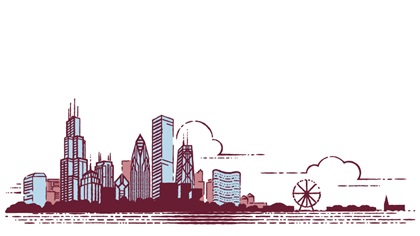 Chicago O’Hare International Airport (ORD) is the busiest airport in the world based on aircraft movements, with an airplane taking off or landing every 34 seconds, on average—around the clock. You might think with O’Hare’s Class B airspace overlying the entire city, general aviation flights would be limited. But that is decidedly not the case. In fact, a favorite activity for visitors and residents, pilots and nonpilots, is a Chicago skyline aerial tour, available from many general aviation airports around Chicagoland. These scenic tours are readily available because the view of the city from above is breathtaking and the route relatively easy to navigate. Expect to pay around $230 for a one-hour flight in a Cessna 172 or Piper Archer including up to three passengers (helicopters tours are also available for a higher fee). However, if you’ve flown your airplane to Chicago, you can take your own tour around the city and preview the many attractions you can visit once back on the ground.
Chicago O’Hare International Airport (ORD) is the busiest airport in the world based on aircraft movements, with an airplane taking off or landing every 34 seconds, on average—around the clock. You might think with O’Hare’s Class B airspace overlying the entire city, general aviation flights would be limited. But that is decidedly not the case. In fact, a favorite activity for visitors and residents, pilots and nonpilots, is a Chicago skyline aerial tour, available from many general aviation airports around Chicagoland. These scenic tours are readily available because the view of the city from above is breathtaking and the route relatively easy to navigate. Expect to pay around $230 for a one-hour flight in a Cessna 172 or Piper Archer including up to three passengers (helicopters tours are also available for a higher fee). However, if you’ve flown your airplane to Chicago, you can take your own tour around the city and preview the many attractions you can visit once back on the ground.
The sun is just peeking over the horizon as you line up for takeoff from Schaumburg Regional Airport (06C). A fleet of Airbus H125 TV news helicopters flies off to the morning’s newsworthy locations and briefly return to refuel, like bees buzzing into and out of their nest. Taking off from Runway 11 you see O’Hare’s six parallel runways a mere seven miles ahead, and spot airliners 1,500 feet above you on final. Be careful to stay below the Class B airspace and don’t  get too close to O’Hare’s inner ring, and you’ll stay out of trouble. Local flight instructor Matt Moglia advises pilots to “commit to altitudes they’ll stick to at certain points of the flight in advance. Also, know which frequencies they’ll need and have them ready. It’s actually a pretty simple flight.”
get too close to O’Hare’s inner ring, and you’ll stay out of trouble. Local flight instructor Matt Moglia advises pilots to “commit to altitudes they’ll stick to at certain points of the flight in advance. Also, know which frequencies they’ll need and have them ready. It’s actually a pretty simple flight.”
Turning north, you aim for Arlington Park, a reporting point on the Chicago VFR Terminal Area Chart and location of the annual Arlington Million horse race. Here you’ll request clearance to transition the Chicago Executive Airport (PWK) Class D airspace toward Lake Michigan (some pilots choose to begin their skyline flight from Chicago Executive because it’s closer to the lake). You’ll pass over the former Naval Air Station Glenview, site of the 1930 National Air Races at which time the aerodrome was called the Curtiss-Reynolds Airport. The naval air station has since been redeveloped into a retail, restaurant, golfing, and housing community called The Glen where the restored air traffic control tower has become its town center.
Poplar Grove




Next, you’re aiming for the Baha’i Temple on the edge of the lake—a prominent landmark resembling a white acorn capping an octagonal base, and another reporting point on the terminal area chart. Once offshore, turn south and prepare to be amazed. The beautiful campus of Northwestern University comes into view, followed by miles of high-rise condos on Chicago’s Gold Coast—named for the wealthy individuals who moved there after the Great Chicago Fire of 1871. To your left the cold blue waters of Lake Michigan—the second largest of North America’s Great Lakes—stretch to the horizon. Soon you’ll see everyone’s favorite attraction: Wrigley Field, home of the Chicago Cubs baseball team. If the Cubs are playing there will be a stadium TFR, forcing you to fly a little farther out over the lake. Try to avoid becoming too engrossed by the amazing view of the city below. There will be traffic along this lakeshore route—sometimes a lot.
 At 120 knots, downtown is approaching quickly. The John Hancock Center (1,500 feet tall including antennas) towers over the Magnificent Mile on Michigan Avenue—the most famous dining and shopping district in Chicago. Here you’ll also find the Chicago Water Tower, a limestone castellated Gothic Revival structure that was one of the few buildings to survive the Great Chicago Fire. Trump International Hotel and Tower rises 1,388 feet above the city and glistens gold in the morning sunlight.
At 120 knots, downtown is approaching quickly. The John Hancock Center (1,500 feet tall including antennas) towers over the Magnificent Mile on Michigan Avenue—the most famous dining and shopping district in Chicago. Here you’ll also find the Chicago Water Tower, a limestone castellated Gothic Revival structure that was one of the few buildings to survive the Great Chicago Fire. Trump International Hotel and Tower rises 1,388 feet above the city and glistens gold in the morning sunlight.
Now you’re flying past the heart of the city, where the Chicago River, its natural course reversed by city engineers in the early 1900s to prevent sewage from flowing into Lake Michigan, bisects the city—necessitating 52 drawbridges, the most in any North American city. As you approach Navy Pier, jutting 3,000 feet into the lake, your eyes are drawn to the 200-foot-tall Centennial Wheel erected in 2016 and sporting enclosed gondolas for year-round enjoyment. The St. Regis Chicago and the Aon Center, both reaching nearly 1,200 feet tall, mark the northern edge of Millennium Park, home to the iconic reflective stainless-steel sculpture titled Cloud Gate but locally known as “the Bean.”
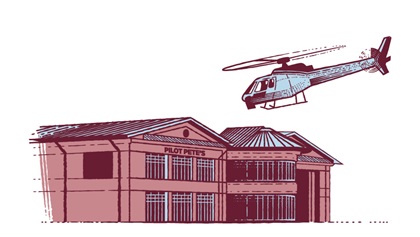 At or above your altitude and dominating the skyline is the Willis Tower (formerly Sears Tower), completed in 1973 and, at 1,729 feet to the tip of its antennas, still the third tallest skyscraper in America. Soldier Field, where the Chicago Bears football team plays, sits across the harbor from Northerly Island—once home to the iconic and beloved downtown GA airport Meigs Field—and anchors the southern extent of the unforgettable views afforded on this skyline tour. Most tours double back north to allow those on the other side of the aircraft to get their own thrilling views of the city, although you can take a shortcut over the Eisenhower Expressway (Interstate 290) and between Chicago Midway International Airport (MDW) and O’Hare airspace to return to Schaumburg Airport. Or, you can circle Midway’s airspace to the south and then fly northwest to Schaumburg.
At or above your altitude and dominating the skyline is the Willis Tower (formerly Sears Tower), completed in 1973 and, at 1,729 feet to the tip of its antennas, still the third tallest skyscraper in America. Soldier Field, where the Chicago Bears football team plays, sits across the harbor from Northerly Island—once home to the iconic and beloved downtown GA airport Meigs Field—and anchors the southern extent of the unforgettable views afforded on this skyline tour. Most tours double back north to allow those on the other side of the aircraft to get their own thrilling views of the city, although you can take a shortcut over the Eisenhower Expressway (Interstate 290) and between Chicago Midway International Airport (MDW) and O’Hare airspace to return to Schaumburg Airport. Or, you can circle Midway’s airspace to the south and then fly northwest to Schaumburg.
Pizzas and Dogs




Dogs and pizza
Back on the ground you’re starving. What to eat? Two Chicago traditions should be on your list—weight and balance permitting.
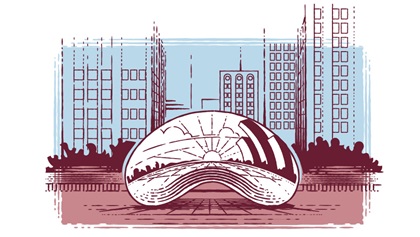 Let’s start with the dogs. Chicago-style hot dogs, to be precise; garnished with mustard, onions, relish, tomatoes, sport peppers, celery salt, and a single pickle spear. Magic on a poppy seed bun. The very best can be found at Portillo’s, a family-owned restaurant chain with more than 60 Chicagoland locations that started with a humble hot dog stand opened by Dick Portillo in 1963. Portillo’s is also famous for its Italian beef sandwiches, which can be shipped frozen to all 50 states—such is the demand from Chicagoans who moved elsewhere. Many Portillo’s locations feature a themed look at Chicago’s history, from the Roaring Twenties through the Great Depression. Décor includes Prohibition-era stills, brewery items, and framed pictures of various gangsters; an authentic 1920s vehicle of the type used by the Chicago mob is suspended overhead. Don’t leave without trying the chocolate cake!
Let’s start with the dogs. Chicago-style hot dogs, to be precise; garnished with mustard, onions, relish, tomatoes, sport peppers, celery salt, and a single pickle spear. Magic on a poppy seed bun. The very best can be found at Portillo’s, a family-owned restaurant chain with more than 60 Chicagoland locations that started with a humble hot dog stand opened by Dick Portillo in 1963. Portillo’s is also famous for its Italian beef sandwiches, which can be shipped frozen to all 50 states—such is the demand from Chicagoans who moved elsewhere. Many Portillo’s locations feature a themed look at Chicago’s history, from the Roaring Twenties through the Great Depression. Décor includes Prohibition-era stills, brewery items, and framed pictures of various gangsters; an authentic 1920s vehicle of the type used by the Chicago mob is suspended overhead. Don’t leave without trying the chocolate cake!
There is a decades-long debate about the best Chicago-style deep dish pizza. Uno’s? Gino’s East? Giordano’s? Nope—in this Chicagoan’s opinion it’s Lou Malnati’s. No matter which pizzeria you visit while in Chicago, bring your biggest appetite. In fact, it might be wise to skip all other meals for the day. Deep dish includes pounds of tasty, gooey, cheesy deliciousness topped with an ocean of tomato sauce; stuffed with fresh ingredients of your choice; and ringed with a tall, flakey crust. Lou and Jean Malnati opened their first pizzeria in 1971 and it has since grown to more than 57 Chicagoland locations.
Side trip
Although there is plenty to keep you busy while flying, driving, or walking around Chicago, 45 miles northwest of the city lies Poplar Grove Airport (C77), and it’s worth a side trip. On the way, make a point of overflying the largest train museum in the country, Illinois Railway Museum in Union, Illinois—so large it’s identified on the terminal area chart. The museum has 450 pieces of historic railway equipment in its collection and offers multiple daily train excursions on its private five-mile-long railroad.
Poplar Grove Airport has three intersecting runways: two grass and one paved. The residential fly-in community here—and it’s a big one, with 100 homes on the airport having taxiway access—uses the exceptionally smooth grass runways almost as frequently as their paved neighbor. This makes for an interesting approach because often, two runways are used simultaneously. It’s a fascinating to watch a steady stream of airplanes interweaving the two traffic patterns, which are offset by 30 degrees.  Some antique airplanes based here have no electrical systems—or radios. So, it’s wise to see and avoid and not count on radio and ADS-B traffic notifications. The reward for landing at Poplar Grove is its friendly residents. Every afternoon during the warmer months, you can count on a welcoming committee in their World-War-II-era jeeps, golf carts, and lawn chairs lined up alongside the grass runways, enjoying the wonderful variety of airplanes using the airport. Many visitors fly or drive in for the monthly Sunday morning EAA pancake breakfasts, or for the airport’s annual fly-in, which attracts hundreds of airplanes and thousands of attendees. A must-see attraction is the Poplar Grove Vintage Wings & Wheels Museum. Housed in a historic 1937 Works Progress Administration hangar relocated from Waukesha, Wisconsin, the museum’s mission places a focus on aviation transportation from 1903 to 1938, and prides itself on telling the stories of the people behind the many airplanes and aviation artifacts in its collection.
Some antique airplanes based here have no electrical systems—or radios. So, it’s wise to see and avoid and not count on radio and ADS-B traffic notifications. The reward for landing at Poplar Grove is its friendly residents. Every afternoon during the warmer months, you can count on a welcoming committee in their World-War-II-era jeeps, golf carts, and lawn chairs lined up alongside the grass runways, enjoying the wonderful variety of airplanes using the airport. Many visitors fly or drive in for the monthly Sunday morning EAA pancake breakfasts, or for the airport’s annual fly-in, which attracts hundreds of airplanes and thousands of attendees. A must-see attraction is the Poplar Grove Vintage Wings & Wheels Museum. Housed in a historic 1937 Works Progress Administration hangar relocated from Waukesha, Wisconsin, the museum’s mission places a focus on aviation transportation from 1903 to 1938, and prides itself on telling the stories of the people behind the many airplanes and aviation artifacts in its collection.
When it’s time to fly back to Chicago, navigation is simple—just aim for the skyscrapers, visible on a clear day as soon as you climb to your cruise altitude.
There are so many airports in Chicagoland, and so many nonflying activities to enjoy, you could easily return many times without ever landing at the same airport or visiting the same attraction twice. But, with the aerial view of the city so intoxicating, I’ll bet it’s one aspect of visiting Chicago you won’t soon tire of.
Email [email protected]


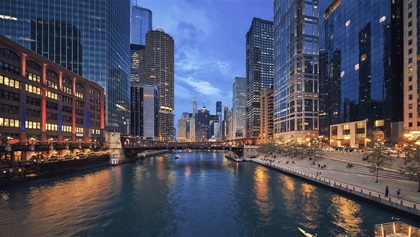 Chicago architecture river cruise. Take a ride on the Chicago River aboard one of Chicago’s First Lady’s fleet to view the best of Chicago’s architecture. The cruise is narrated by docents from the Chicago Architecture Center, and is a unique way to see and learn about the city.
Chicago architecture river cruise. Take a ride on the Chicago River aboard one of Chicago’s First Lady’s fleet to view the best of Chicago’s architecture. The cruise is narrated by docents from the Chicago Architecture Center, and is a unique way to see and learn about the city. 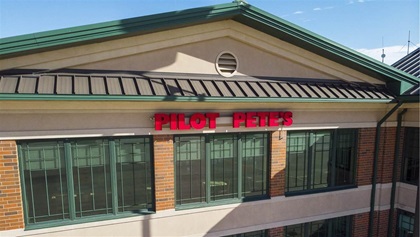 Schaumburg Regional Airport, is a favorite Chicagoland destination for pilots and passengers craving a $100 hamburger. Open for lunch and dinner.
Schaumburg Regional Airport, is a favorite Chicagoland destination for pilots and passengers craving a $100 hamburger. Open for lunch and dinner. 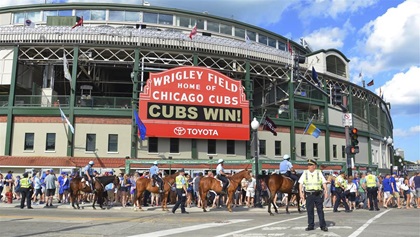 Wrigley Field. This iconic baseball stadium first opened in 1914 and is home to the Chicago Cubs. A must-visit for any baseball fan.
Wrigley Field. This iconic baseball stadium first opened in 1914 and is home to the Chicago Cubs. A must-visit for any baseball fan.

